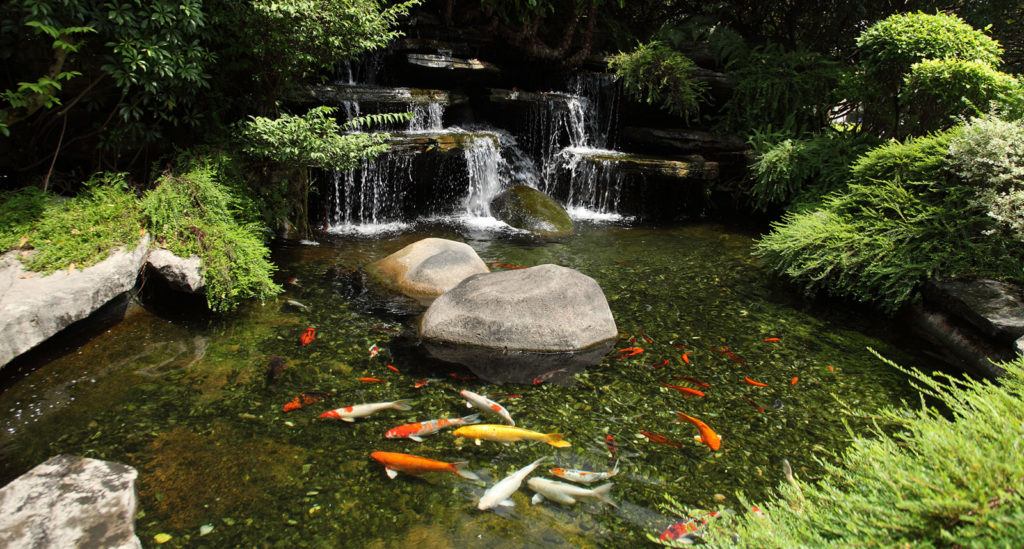You’ve done it. The new pond is installed in your Pacific Northwest backyard, complete with waterfall, and, boy, is it a beauty! You’ve added a few koi to add color and a touch of relaxation when you’re sitting next to the water. A pond plant or two gives the fish something to hide in, and you something to delight in as you sit back, put your feet up, and soak in the wonder of the new crowning jewel of your backyard. Now all you need to do is relax and enjoy your new water feature, right? Sadly, no. Next comes the upkeep and maintenance.
There are many culprits that affect the cleanliness (or lack thereof) of your pond. Falling leaves, dirt, dust, even your fine new fish can all contribute to a dirty, scum-filled pond.
Fish produce ammonia from both their gills and kidneys. If allowed to remain, it can, in turn, be toxic to the fish. Even the food pellets you sprinkle at the surface can produce unclean water, as the uneaten bits float to the bottom. Frequent water changes can be helpful, but a filter or bio-filter is a must.
Leaves are some of the worst pond-villains. In a short time, they can completely cover your pond. If left unchecked, they’ll sink and decompose, resulting in poor water quality. They can also produce ammonia, adding to the likely demise of the fish you paid a pretty penny to own! The result may be murky, cloudy, smelly, or even toxic water, as well as dead fish—not the kind of environment you were hoping for.
Before you get out the shovels and the backhoe and prepare to tear it up, let us assure you that it doesn’t have to be difficult to maintain a healthy environment in your pond.
Here are a few “must-have” items for your pond to flourish.
- Filtration: A great filtration system is a key component in maintaining good water quality. There are many pond filters available on the market. Make sure to get the right one for the size of your pond. Keep the filters clean or replace as needed.
- Pond pump: A pond pump provides aeration of the water. The attachment of various nozzles can add drama in the pond by adding spits, trickles and shooting fountains.
- Bio-filters: Biofiltrationis a pollution control technique using living material to capture and biologically degrade pollutants. While not essential, they can greatly increase the health of your pond. Simple biofilters for pond use can consist of black or green boxes submerged in the pond. The boxes hold sponges, brushes or other means of trapping solid particles. They also contain plastic tubing, plastic balls, other plastic shapes, lava rock, special tape, string bags or coke bottle tops, all designed to support the growth of “good” bacteria. The biofilter has a few needs of its own:
- A good mechanical filtration system to clean the water before it gets to the biofilter.
- A large quantity of beneficial bacteria to eat the waste products of the fish. Beneficial bacterias include Nitrosomonas bacteria, which consumes the ammonia, turning it into nitrites (harmful to fish); and Nitrobacter bacteria, which then oxidizes the nitrites into nitrates. This becomes food for the plants in your pond.
- A continuous supply of oxygen provided by the pumps aeration.
- Good water flow through the biofilter.
- A long handled leaf rake or scoop will enable you to easily and quickly scoop the leaves from the water’s surface. These can be purchased from your local nursery, Home Depot or Lowe’s, or even purchased online.
- A pond vacuum can help suck up the debris that collects on the bottom.
- Certain plants, like Anacharis, a bristly looking vigorous grower, actually help prevent algae growth.
- Last, but certainly not least, the cheapest way to kill algae in a pond is to put a bottle of hydrogen peroxide in once per week. Add 32oz per 500 gallons. It doesn’t hurt the fish. But, always use the correct dosage! If you think some is great, why not use more and decide to use more than suggested, you’re going to do a lot of long-term damage, including stunted plant growth and other mini-ecological disasters. Use moderately, as recommended here.
Make a schedule for your pond and stick to it. This way it will become a matter of course, and not take up too much of your valuable time. And, you’ll be able to enjoy your pond for years to come with minimal care.
